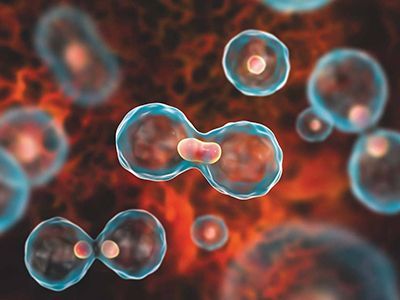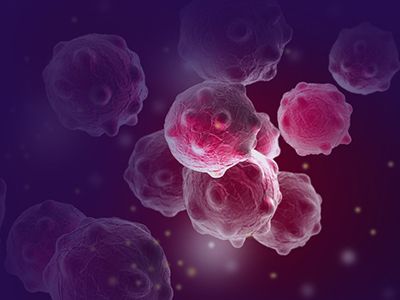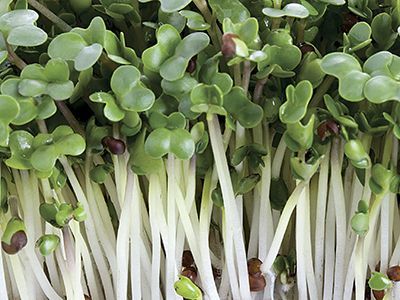Dr. Pamela's Blog
How to Prevent a Cancer Recurrence: Cancer Stem Cells Explained
One of the scarier words that anyone can hear in relation to themselves or a loved one is cancer, second of which is recurrence. One of the questions that my patients frequently ask is “why has this cancer returned?” or alternately, “how do I keep this cancer from coming back?” I frequently find myself explaining the role of cancer stem cells or “cancer seeds” to my patients. One of the hallmarks of all cancers is the capacity for unlimited self-renewal, which is also a defining characteristics of normal stem cells.

What Are Stem Cells
Stem cells are a unique subset of cells in our bodies. They have several things that make them special. They are immortal and give rise to all of the different cells in our body. They don’t have a specific function themselves, in the way cardiac muscles contract, or retinal cells process light for example. Rather, their purpose is to know how to make a cell that knows how to carry out those functions—otherwise known as a differentiated cell. When cells normally divide, they create two of the same cell. However, when stem cells divide, they create two different cells – one that remains a stem cell, replenishing the stem cell population, and a daughter cell that differentiates into a functional cell.
There are several different types of stem cells:
Embryonic Stem cells
Embryonic stem cells are the type of stem cell that has been the subject of so much press and ethical debate. Embryonic stem cells are found in a blastocyst, which is formed four to five days after fertilization and several days before implantation. Once the blastocyst implants, the embryonic stem cells begin to differentiate. Embryonic stem cells are called pluripotent, which means that they can, and do, become literally any cell in the body.
Adult Stem Cells
Adult stem cells are similar to embryonic stem cells in that they are immortal and undifferentiated (they don’t form a specific function). When they divide, they produce both another stem cell (self-regenerative) and a daughter cell that differentiates into a functional cell, which will replenish dying cells and regenerate damaged tissue. Adult stem cells are sometimes called somatic stem cells, and they can be found in children as well as adults. What makes these stem cells different from embryonic stem cells is that they cannot produce a differentiated daughter that can become any cell type, but rather can only differentiate into a limited type of functional cells. We have a few of these stem cells scattered throughout our bodies to serve as a repair system to provide new healthy organ, muscle, bone, nerve and blood cells, as older cells get damaged.

Cancer Stem Cells
For a long time it was thought that a tumor was homogenous, meaning that it was comprised of a single cell type that had replicated itself over and over again. However, it is now known that there are at least two cell types within the tumor, the cancer stem cell (CSC), and the fully differentiated cancer cells. The differentiated cancer cells have all of the characteristics that we think of when we think of cancer cells – they grow quickly, they divide rapidly, they are shaped abnormally, and help create an inflammatory environment that feeds the cancer.
Cancer stem cells share many of the same characteristics of embryonic and somatic cancer stem cells. They too are immortal, self-renew, and form daughter cells that differentiate into tumor cells. However, unlike traditional cancer cells, CSCs divide very slowly and maintain more cellular machinery. Cancer stem cells are responsible for tumor genesis, metastases, recurrence and drug resistance.

How long have we known about cancer stem cells?
On some level we have thought of cancer and its ability to metastasize into distant removed sites as seeds. This understanding came about in 1889 when Steven Paget published his “seed and soil” hypothesis. However, in the early 1970’s there were several studies from Park and co-workers which found that some leukemic cells could re-produce a tumor and others could not. In 1997, there were two studies by Blair and another by Bonnet and Dick, which definitively found cancer stem cells in a line of AML cells. In these studies, they found that some of the leukemic cells had unique proteins on their surface. When these cells were isolated they consistently reproduced cancers that were identical to the original cancer. They were able to “grow” new cancers in both cell cultures and when injected into specialized immune deficient mice.
Since these studies were published, scientists have found correlative cancer stem cells in solid tumors, including, but not limited to, brain, breast, lung, melanoma, prostate, pancreas, colon, gastric and lung. It is important to know that differentiated cancer cells cannot produce another tumor, much like an apple leaf cannot grow a new tree, only an apple seed can.
Where do cancer stem cells come from?
Cancer stem cells arise from healthy somatic stem cells that have acquired genetic mutations to become cancerous. In some respects, they are ideally situated to do so in that they already have the self-renewal machinery activated. Additionally, because somatic stem cells persist throughout life, they have much greater opportunities to accumulate mutations than more mature cells, which endure only for a short period.
We have always thought that stem cell to differentiated cell was a one-way process. However, we are learning that under certain conditions, a differentiated cell can actually de-differentiate and become more stem like. Not only can this happen in our bodies, but scientists have successfully accomplished this in laboratory settings.
Effect of Chemotherapy and Radiation on Cancer Stem Cells
Chemotherapy and radiation work by targeting weaknesses exhibited by rapidly dividing cells. This explains some of the more acute side effects of radiation—hair loss, nausea/vomiting, and lowered blood counts. This is because hair, GI tract, and blood marrow are our normal healthy cells that divide rapidly and are therefore more vulnerable to the effects of the chemotherapy or radiation. However, cancer stem cells-- just like all stem cells, do not divide rapidly, in fact they divide much slower than any other cell type. This makes them immune to both chemotherapy and radiation.
Not only do cancer stem cells divide too slowly to be affected by chemotherapy and radiation, they retain much more of the cellular mechanisms that are able to manage the chemical fallout of these treatments, which improves their survival capacity. It also gives them the ability to adapt to the treatment and become drug resistant. When these drug resistant stem cells repopulate a tumor, even the daughter fully differentiated cancer cells are no longer susceptible to treatment.
Furthermore, damage from chemotherapy and radiation also triggers the de-dedifferentiation pathways to cause that regression we were speaking about. We end up getting new cancer stem cells, which often have additional mutations, so they are frequently more aggressive. Both of these treatments will also trigger something called Epithelial to Mesenchymal Transition or EMT. What this means is that it encourages cells to transform from epithelial cells, which are linked together and stay in one place, to mesenchymal cells, which are cells that are not attached to other cells and shaped perfectly for walking around. This is really just another way to say that these cells are primed for metastasis. If we only treat the rapidly dividing differentiated cancer cells, then the tumor can shrink. However, the seeds are left to regrow another, often more aggressive tumor.
I want to be clear, even given the above information, that chemotherapy doesn’t have a role to play in current cancer treatment—it does. We just need to adjust our thinking on it. Because chemotherapy isn’t able to address cancer stem cells, it usually isn’t curative. However, it often will shrink tumors.
Let’s go back to Paget’s idea of “seed and terrain” theory of cancer cells. I like to think of our bodies like a garden. So the question becomes this: is the soil prepared to nurture healthy cells or prepared to enhance cancer cells? This is essentially what the terrain is. Cancer cells release different chemical mediators to make the soil more conducive to cancer cells. Sometimes it is necessary to debulk the tumor and therefore turn down those messages.
Are there any conventional treatments that DO address cancer stem cells?
The short is answer is yes, a handful. Remember in those first experiments in 1997, the scientists found unique proteins on the cell surfaces of the leukemic cancer stem cells. Think of it like little hats that only cancer stem cells wear. It turns out that all cancer stem cells wear these hats. And, even better, these hats can be slightly different depending on what type of cancer cell it is. But the best news is that these surface proteins are the start of entire signaling cascades that are unique to stem cells. These signaling pathways are often found in embryonic development with healthy stem cells. They have funny names like hedgehog, notch, twist and many others. These signaling pathways often present opportunities for therapeutic intervention.
One of the first of these drugs is vismodegib, which is used to treat locally invasive or metastatic basal cell carcinoma. The story of this drug’s origin is interesting. In the 1950’s there were mysterious episodic outbreaks of cyclopic lambs – lambs born with only one eye. This was painstakingly traced to the sheep grazing on Veratrum californicum, or corn lily, early in pregnancy. This led to the discovery of the steroid alkaloid cyclopamine, which was the compound responsible for this birth defect. Exactly how it worked remained a mystery for over thirty years until scientists found the signaling pathway called hedgehog in stem cells during early embryonic development and found that cyclopamine interfered with this pathway. Vismodegib is based on cyclopamine, and its ability to inhibit the hedgehog signaling pathway.
Herceptin is another common pharmaceutical used to treat Her2 positive breast cancer, which addresses breast cancer stem cells. Her2 is protein on the outside of cells, which is a receptor for a growth factor. Prior to Herceptin (Trastuzumab), cancer cells that had a lot of the Her2 protein receptor were very aggressive and difficult to treat, which makes sense because growth factor makes things grow quickly. However now, with Herceptin, getting a Her2 positive marker is good news, since the Herceptin will eliminate the cancer stem cell, not just the differentiated cancer cells

Herbal Allies
One of the challenges of using pharmaceutical agents to address cancer stem cells is that they often have strong adverse side effects. For instance, in a 2017 study of vismodegib that we spoke about earlier, over half of participants discontinued treatment due to intolerable side effects. This is where herbs come in. We have study after study showing the positive impacts of herbs on cancer stem cells. The ones that come up the most frequently are Curcumin, Resveratrol, Green tea, and Quercetin. This is followed quickly by Boswellia, Holy Basil, Honokiol, Milk Thistle, Ginseng, and many more.
Remember we spoke about signaling cascades earlier? What does that even mean? A signaling cascade is essentially a wacky Rube Goldberg Machine in our bodies – where one protein causes a change in the next protein, which causes the next thing, down the line to essentially change how our DNA is processed. Let’s go back to vismodegib and how it effects the signaling cascade called Hedgehog. Notably, so does Curcumin, Resveratrol, Quercetin, and Green Tea. Drugs affect only one signaling cascade in a very strong way, which often leads to harsh side effects. On the other hand, herbs commonly affect multiple signaling cascades in a gentle way, leading to reduced side effects.
In cancers we have one (or more) of three problems: the gas pedal, or growth and division, is pressed too hard; the brakes, or inhibitors, aren’t working; or the signal to call it quits, immortality, doesn’t get sent. What we commonly see with herbs is that they are able to address the specific cancer stem cell pathways such as hedgehog, notch, twist, etc., as well as let up on the gas pedal of growth and increase the brakes. Our top four are excellent at decreasing inflammation, inhibition of inappropriate angiogenesis (new blood vessels forming to feed a cancer), decreasing cancer cells stemness, reigniting appropriate apoptosis, and decreasing ability to metastasize.

Nutritional Intervention
It’s not just herbs that have positive impacts on cancer stem cells – nutrition plays an important role too. There are great studies on genistein from soy, chrysin from honey and propolis, and sulforaphane from broccoli and especially broccoli sprouts. We’ve always known that flavones, anthocyanins, and other phytochemicals from fruits and vegetables prevent and help fight cancers
Autophagy and Apoptosis
The last concept that I want to touch on very briefly is autophagy and apoptosis. Our bodies are designed to recognize when our proteins and cells have become damaged and need to be recycled and eliminated. Essentially, both autophagy and apoptosis are the process of our bodies neatly rolling up damaged proteins (autophagy) and even whole cells (apoptosis) into tidy bundles either for parts to be reused, or broken down and eliminated. These processes get turned off in both cancer cells and in cancer stem cells. It turns out that an effective way of dealing with cancer stem cells is essentially to re-engage this process. Many of the herbs and nutrients that we spoke about do this as well, such as curcumin, green tea, resveratrol, and sulforaphane. However, fasting is another powerful tool to encourage autophagy and apoptosis. Both intermitant fasting, which increases intervals between first and last meal, and 24-hour fasts have been proven to ramp up autophagy and apoptosis.
(For a list of works consulted, please see the bibliography below)
Join the Mederi Center community by signing up for our email list! We send several emails a month with product promotions for patients, practical tips for healthy living, blogs written by our practitioners, information about events, and other news. You can unsubscribe at any time.
Bibliography
Shi Y, Inoue H, Wu JC, Yamanaka S. Induced pluripotent stem cell technology: a decade of progress. Nat Rev Drug Discov. 2017 Feb;16(2):115-130. doi: 10.1038/nrd.2016.245. Epub 2016 Dec 16. PMID: 27980341; PMCID: PMC6416143.
Langley RR, Fidler IJ. The seed and soil hypothesis revisited--the role of tumor-stroma interactions in metastasis to different organs. Int J Cancer. 2011;128(11):2527-2535. doi:10.1002/ijc.26031
Xiang L, Semenza GL. Hypoxia-inducible factors promote breast cancer stem cell specification and maintenance in response to hypoxia or cytotoxic chemotherapy. Adv Cancer Res. 2019;141:175-212. doi: 10.1016/bs.acr.2018.11.001. Epub 2018 Dec 19. PMID: 30691683.
Lee SY, Jeong EK, Ju MK, Jeon HM, Kim MY, Kim CH, Park HG, Han SI, Kang HS. Induction of metastasis, cancer stem cell phenotype, and oncogenic metabolism in cancer cells by ionizing radiation. Mol Cancer. 2017 Jan 30;16(1):10. doi: 10.1186/s12943-016-0577-4. PMID: 28137309; PMCID: PMC5282724.
Klonisch T, Wiechec E, Hombach-Klonisch S, Ande SR, Wesselborg S, Schulze-Osthoff K, Los M. Cancer stem cell markers in common cancers - therapeutic implications. Trends
Mol Med. 2008 Oct;14(10):450-60. doi: 10.1016/j.molmed.2008.08.003. Epub 2008 Sep 3. PMID: 18775674.
26. Singh SK, et al. Nature. 2004;432:396-401. 27. Al-Hajj M, et al. Proc Natl Acad Sci U S A. 2003;100:3983-3988. 28. O’Brien CA, et al. Nature. 2007;445:106-110. 29. Eramo A, et al. Cell Death Differ. 2008;15:504-14. 30. Fang D, et al. Cancer Res. 2005;65:9328-9337. 31. Li C, et al. Cancer Res. 2007;67:1030-1037. 32. Du L, et al. Clin Cancer Res. 2008;14:6751-6760. 33. Lapidot T, et al. Nature. 1994;367:645-648. 34. Guzman ML, et al. Cancer Control. 2004;11:97-104.
Aditya S, Rattan A. Vismodegib: A smoothened inhibitor for the treatment of advanced basal cell carcinoma. Indian Dermatol Online J. 2013 Oct;4(4):365-8. doi: 10.4103/2229-5178.120685. PMID: 24350028; PMCID: PMC3853913.
Chen JK. I only have eye for ewe: the discovery of cyclopamine and development of Hedgehog pathway-targeting drugs. Nat Prod Rep. 2016;33(5):595-601. doi:10.1039/c5np00153f
Sekulic A, Migden MR, Basset-Seguin N, Garbe C, Gesierich A, Lao CD, Miller C, Mortier L, Murrell DF, Hamid O, Quevedo JF, Hou J, McKenna E, Dimier N, Williams S, Schadendorf D, Hauschild A; ERIVANCE BCC Investigators. Long-term safety and efficacy of vismodegib in patients with advanced basal cell carcinoma: final update of the pivotal ERIVANCE BCC study. BMC Cancer. 2017 May 16;17(1):332. doi: 10.1186/s12885-017-3286-5. Erratum in: BMC Cancer. 2019 Apr 18;19(1):366. PMID: 28511673; PMCID: PMC5433030.
Pistollato F, Calderón Iglesias R, Ruiz R, Aparicio S, Crespo J, Dzul Lopez L, Giampieri F, Battino M. The use of natural compounds for the targeting and chemoprevention of ovarian cancer. Cancer Lett. 2017 Dec 28;411:191-200. doi: 10.1016/j.canlet.2017.09.050. Epub 2017 Oct 7. PMID: 29017913.
Almeneessier AS, BaHammam AA, Alzoghaibi M, Olaish AH, Nashwan SZ, BaHammam AS. The effects of diurnal intermittent fasting on proinflammatory cytokine levels while controlling for sleep/wake pattern, meal composition and energy expenditure. PLoS One. 2019 Dec 10;14(12):e0226034. doi: 10.1371/journal.pone.0226034. PMID: 31821377; PMCID: PMC6903761.
Wang YH, Scadden DT. Harnessing the apoptotic programs in cancer stem-like cells. EMBO Rep. 2015;16(9):1084-1098. doi:10.15252/embr.201439675
Autophagy, cancer stem cells and drug resistance Alexandra G Smith1,2,3Kay F Macleod1,2,3,* 1The Ben May Department for Cancer Research, The
Gordon Center for Integrative Sciences, The University of Chicago, Chicago, IL, USA 2The Committee on Cancer Biology, The University of Chicago, Chicago, IL, USA 3Multi-disciplinary Training Grant in Cancer Research, University of Chicago, Chicago, IL, USA
Cheng CW, Adams GB, Perin L, et al. Prolonged fasting reduces IGF-1/PKA to promote hematopoietic-stem-cell-based regeneration and reverse immunosuppression [published correction appears in Cell Stem Cell. 2016 Feb 4;18(2):291-2]. Cell Stem Cell. 2014;14(6):810-823. doi:10.1016/j.stem.2014.04.014
Sharif T, Martell E, Dai C, et al. Autophagic homeostasis is required for the pluripotency of cancer stem cells. Autophagy. 2017;13(2):264-284. doi:10.1080/15548627.2016.1260808
Pourquié O. Human embryonic stem cells get organized. Nature. 2018 Jun;558(7708):35-36. doi: 10.1038/d41586-018-05115-y. PMID: 29872182.
Akhtar M, Haider A, Rashid S, Al-Nabet ADMH. Paget's "Seed and Soil" Theory of Cancer Metastasis: An Idea Whose Time has Come. Adv Anat Pathol. 2019 Jan;26(1):69-74. doi: 10.1097/PAP.0000000000000219. PMID: 30339548.
Christiansen JJ, Rajasekaran AK. Reassessing epithelial to mesenchymal transition as a prerequisite for carcinoma invasion and metastasis. Cancer Res. 2006 Sep 1;66(17):8319-26. doi: 10.1158/0008-5472.CAN-06-0410. PMID: 16951136.
Epithelial-mesenchymal transitions: insights from development
Jormay Lim, Jean Paul Thiery
Development 2012 139: 3471-3486; doi: 10.1242/dev.071209
Du FY, Zhou QF, Sun WJ, Chen GL. Targeting cancer stem cells in drug discovery: Current state and future perspectives. World J Stem Cells. 2019;11(7):398-420. doi:10.4252/wjsc.v11.i7.398
Shibata M, Hoque MO. Targeting Cancer Stem Cells: A Strategy for Effective Eradication of Cancer. Cancers (Basel). 2019;11(5):732. Published 2019 May 27. doi:10.3390/cancers11050732
Singh JK, Simões BM, Howell SJ, Farnie G, Clarke RB. Recent advances reveal IL-8 signaling as a potential key to targeting breast cancer stem cells. Breast Cancer Res. 2013;15(4):210. doi: 10.1186/bcr3436. PMID: 24041156; PMCID: PMC3978717.
Du FY, Zhou QF, Sun WJ, Chen GL. Targeting cancer stem cells in drug discovery: Current state and future perspectives. World J Stem Cells. 2019 Jul 26;11(7):398-420. doi: 10.4252/wjsc.v11.i7.398. PMID: 31396368; PMCID: PMC6682504.
Khan AQ, Ahmed EI, Elareer NR, Junejo K, Steinhoff M, Uddin S. Role of miRNA-Regulated Cancer Stem Cells in the Pathogenesis of Human Malignancies. Cells. 2019;8(8):840. Published 2019 Aug 5. doi:10.3390/cells8080840
McCubrey JA, Lertpiriyapong K, Steelman LS, et al. Effects of resveratrol, curcumin, berberine and other nutraceuticals on aging, cancer development, cancer stem cells and microRNAs. Aging (Albany NY). 2017;9(6):1477-1536. doi:10.18632/aging.101250
Passegué E, Jamieson CH, Ailles LE, Weissman IL. Normal and leukemic hematopoiesis: are leukemias a stem cell disorder or a reacquisition of stem cell characteristics? Proc Natl Acad Sci U S A. 2003 Sep 30;100 Suppl 1(Suppl 1):11842-9. doi: 10.1073/pnas.2034201100. Epub 2003 Sep 22. PMID: 14504387; PMCID: PMC304096.
Hanahan D, Weinberg RA. Hallmarks of cancer: the next generation. Cell. 2011 Mar 4;144(5):646-74. doi: 10.1016/j.cell.2011.02.013. PMID: 21376230.
Podberezin M, Wen J, Chang CC. Cancer stem cells: a review of potential clinical applications. Arch Pathol Lab Med. 2013 Aug;137(8):1111-6. doi: 10.5858/arpa.2012-0494-RA. Epub 2012 Nov 15. PMID: 23153183.
Sun HR, Wang S, Yan SC, Zhang Y, Nelson PJ, Jia HL, Qin LX, Dong QZ. Therapeutic Strategies Targeting Cancer Stem Cells and Their Microenvironment. Front Oncol. 2019 Oct 24;9:1104. doi: 10.3389/fonc.2019.01104. PMID: 31709180; PMCID: PMC6821685.
Vlashi E, Pajonk F. Cancer stem cells, cancer cell plasticity and radiation therapy. Semin Cancer Biol. 2015 Apr;31:28-35. doi: 10.1016/j.semcancer.2014.07.001. Epub 2014 Jul 12. PMID: 25025713; PMCID: PMC4291301.
Scarpa ES, Ninfali P. Phytochemicals as Innovative Therapeutic Tools against Cancer Stem Cells. Int J Mol Sci. 2015 Jul 10;16(7):15727-42. doi: 10.3390/ijms160715727. PMID: 26184171; PMCID: PMC4519921.
Tang SN, Singh C, Nall D, Meeker D, Shankar S, Srivastava RK. The dietary bioflavonoid quercetin synergizes with epigallocathechin gallate (EGCG) to inhibit prostate cancer stem cell characteristics, invasion, migration and epithelial-mesenchymal transition. J Mol Signal. 2010 Aug 18;5:14. doi: 10.1186/1750-2187-5-14. PMID: 20718984; PMCID: PMC2933702.
Khan S, Karmokar A, Howells L, Thomas AL, Bayliss R, Gescher A, Brown K. Targeting cancer stem-like cells using dietary-derived agents - Where are we now? Mol Nutr Food Res. 2016 Jun;60(6):1295-309. doi: 10.1002/mnfr.201500887. Epub 2016 May 11. PMID: 27060283.
Plaks V, Kong N, Werb Z. The cancer stem cell niche: how essential is the niche in regulating stemness of tumor cells? Cell Stem Cell. 2015 Mar 5;16(3):225-38. doi: 10.1016/j.stem.2015.02.015. PMID: 25748930; PMCID: PMC4355577.
Ginestier C, Liu S, Diebel ME, Korkaya H, Luo M, Brown M, Wicinski J, Cabaud O, Charafe-Jauffret E, Birnbaum D, Guan JL, Dontu G, Wicha MS. CXCR1 blockade selectively targets human breast cancer stem cells in vitro and in xenografts. J Clin Invest. 2010 Feb;120(2):485-97. doi: 10.1172/JCI39397. Epub 2010 Jan 4. PMID: 20051626; PMCID: PMC2810075.
Tang SN, Singh C, Nall D, Meeker D, Shankar S, Srivastava RK. The dietary bioflavonoid quercetin synergizes with epigallocathechin gallate (EGCG) to inhibit prostate cancer stem cell characteristics, invasion, migration and epithelial-mesenchymal transition. J Mol Signal. 2010 Aug 18;5:14. doi: 10.1186/1750-2187-5-14. PMID: 20718984; PMCID: PMC2933702.
Singh JK, Simões BM, Howell SJ, Farnie G, Clarke RB. Recent advances reveal IL-8 signaling as a potential key to targeting breast cancer stem cells.
Breast Cancer Res. 2013;15(4):210. doi: 10.1186/bcr3436. PMID: 24041156; PMCID: PMC3978717.


